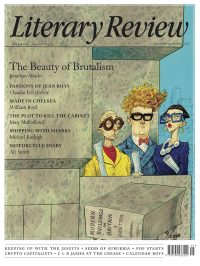David Boyd Haycock
The Radicalism of a Watercolour
The Real and the Romantic: English Art Between Two World Wars
By Frances Spalding
Thames & Hudson 384pp £35
Kierkegaard’s observation that life can only be understood backwards but must be lived forwards is pertinent to any attempt to understand art history. Artists move uncertainly, experimenting, growing, absorbing, discovering, forgetting, rediscovering. It is the difficult task of the art historian to piece a narrative together – and all art historians have their biases and blind spots. Frances Spalding admits as much in her introduction to The Real and the Romantic: ‘This book is neither a survey history of the period nor a deliberate alternative to mainstream history,’ she writes. ‘It is a response to a need for a particular focus on key moments, sudden alliances and shifts in feeling that fed into the creativity of this period … Readers may detect a recurrent interest in the interconnectedness of artistic networks and an interest in bringing to the fore women’. Throughout the book, she unravels the complexities of English art between the wars with clarity and confidence, moving back and forth in time, and between artists, writers, critics, curators and collectors.
Much of the art produced during and after the First World War was extraordinarily powerful. Spalding directs our attention to Sir Edwin Lutyens’s Cenotaph in Whitehall, Charles Sargeant Jagger’s Royal Artillery Monument at Hyde Park Corner, the paintings of the brothers John and Paul Nash, and John Singer Sargent’s

Sign Up to our newsletter
Receive free articles, highlights from the archive, news, details of prizes, and much more.@Lit_Review
Follow Literary Review on Twitter
Twitter Feed
It wasn’t until 1825 that Pepys’s diary became available for the first time. How it was eventually decrypted and published is a story of subterfuge and duplicity.
Kate Loveman tells the tale.
Kate Loveman - Publishing Pepys
Kate Loveman: Publishing Pepys
literaryreview.co.uk
Arthur Christopher Benson was a pillar of the Edwardian establishment. He was supremely well connected. As his newly published diaries reveal, he was also riotously indiscreet.
Piers Brendon compares Benson’s journals to others from the 20th century.
Piers Brendon - Land of Dopes & Tories
Piers Brendon: Land of Dopes & Tories - The Benson Diaries: Selections from the Diary of Arthur Christopher Benson by Eamon Duffy & Ronald Hyam (edd)
literaryreview.co.uk
Of the siblings Gwen and Augustus John, it is Augustus who has commanded most attention from collectors and connoisseurs.
Was he really the finer artist, asks Tanya Harrod, or is it time Gwen emerged from her brother’s shadow?
Tanya Harrod - Cut from the Same Canvas
Tanya Harrod: Cut from the Same Canvas - Artists, Siblings, Visionaries: The Lives and Loves of Gwen and Augustus John by Judith Mackrell
literaryreview.co.uk